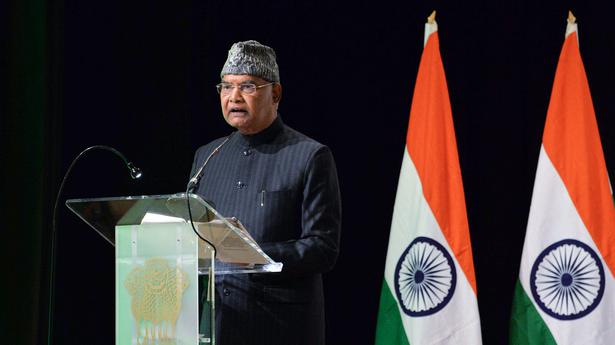
The process of electing India’s President
The Hindu
Will the recent Assembly Elections impact the presidential election in July? How is the vote value for each MP/MLA calculated?
The story so far: The tenure of the current President of India Ram Nath Kovind is set to end in July this year, which is also when the 16th Indian Presidential election will be held to elect his successor. The Assembly elections held in five States this year, and the changes in the National Democratic Alliance (NDA), are expected to alter the dynamic of votes in the upcoming presidential race.
The Indian President is elected through an electoral college system, wherein the votes are cast by national and State-level lawmakers. The elections are conducted and overseen by the Election Commission (EC) of India.
The electoral college is made up of all the elected members of the Upper and Lower Houses of Parliament (Rajya Sabha and Lok Sabha MPs), and the elected members of the Legislative Assemblies of States and Union Territories (MLAs). This means, in the upcoming polls, the number of electors will be 4,896 — 543 Lok Sabha MPs, 233 MPs of the Rajya Sabha, and 4,120 MLAs of all States, including the National Capital Territory (NCT) of Delhi and Union Territory of Puducherry.
Before the voting, comes the nomination stage, where the candidate intending to stand in the election, files the nomination along with a signed list of 50 proposers and 50 seconders. These proposers and seconders can be anyone from the total of 4,896 members of the electoral college from the State and national level. The rule for securing 50 proposers and seconders was implemented when the EC noticed, in 1974, that several candidates, many without even a bleak chance of winning, would file their nominations to contest the polls. An elector cannot propose or second the nomination of more than one candidate.
A vote cast by each MP or MLA is not calculated as one vote. There is a larger vote value attached to it.
The fixed value of each vote by an MP of the Rajya Sabha and the Lok Sabha is 708. Meanwhile, the vote value of each MLA differs from State to State based on a calculation that factors in its population vis-a-vis the number of members in its legislative Assembly. As per the Constitution (Eighty-fourth Amendment) Act 2001, currently, the population of States is taken from the figures of the 1971 Census. This will change when the figures of the Census taken after the year 2026 are published.
The value of each MLA’s vote is determined by dividing the population of the State by the number of MLAs in its legislative Assembly, and the quotient achieved is further divided by 1000. Uttar Pradesh for instance, has the highest vote value for each of its MLAs, at 208. The value of one MLA’s vote in Maharashtra is 175, while that in Arunachal Pradesh is just 8. The total votes of each Legislative Assembly are calculated by multiplying the vote value of each MLA by the number of MLAs.













